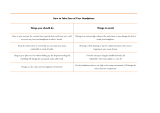
9
Switches and Operation
1. The UP and DOWN switches allow you to navigate through presets. Press once for a single
preset change. Press and HOLD to quickly move through presets.
2. HIT/TALK – In normal operation, this button acts as a HIT button. When activated, a new
effect or effects will be added to the current patch. This feature is perfect for adding effects like
Harmony to a chorus section of a song, or even to a single line or word.
3. When you press and HOLD the HIT/TALK button, the VoiceLive Play enters TALK mode.
All effect output is muted and the mic input is passed directly to the output. This is especially
effective when a singer may want to speak to the crowd without any effects present on their
voice.
4. To enter LOOP mode, press and hold the UP and DOWN switches simultaneously. Once in
LOOP mode, the DOWN footswitch controls REC/PLAY/OVERDUB functions, the UP
footswitch controls the STOP/CLEAR functions and the HIT button exits LOOP mode. You
may exit loop mode while a loop is still playing. That means you can choose a new vocal sound
and then re-enter LOOP mode to add a new overdub to the loop. Press and hold the DOWN
footswitch after performing an OVERDUB to UNDO.
*LOOP mode is the default action when pressing the UP and DOWN buttons simultaneously. The al-
ternative mode, set on SYSTEM page 5 under UP/DN Function is KEY/SCALE mode, described below.
5. To access TAP TEMPO, press and hold the UP and HIT switches simultaneously. Once you
see the tempo on the LCD screen, tap the HIT button in time with your music. When you’re
nished, stop tapping and the screen will “time out” back to the preset screen. Voila!
6. To enter KEY/SCALE mode and select the KEY/SCALE to be used with Harmony and Hard
tune effects, press and hold the UP and DOWN switches simultaneously. To save your select-
ed KEY/SCALE, press EXIT.
*If you don’t know the KEY/SCALE that a particular song is in, try using the last chord of the song for
the KEY and Major 2 for the SCALE. It’s often correct, especially in popular music.
Basics




















